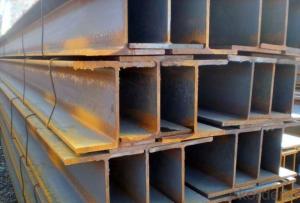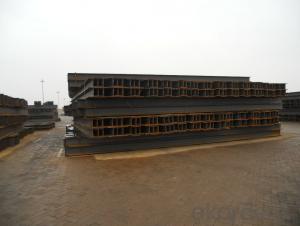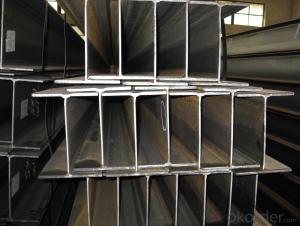carbon steel H BEAM for construction JIS G 3192
- Loading Port:
- Tianjin
- Payment Terms:
- TT or LC
- Min Order Qty:
- 25 m.t.
- Supply Capability:
- 100000 m.t./month
OKorder Service Pledge
OKorder Financial Service
You Might Also Like
Product Description:
OKorder is offering carbon steel H Beam for construction JIS G 3192 at great prices with worldwide shipping. Our supplier is a world-class manufacturer of steel, with our products utilized the world over. OKorder annually supplies products to European, North American and Asian markets. We provide quotations within 24 hours of receiving an inquiry and guarantee competitive prices.
Product Applications:
Carbon steel H Beam are ideal for structural applications and are widely used in the construction of buildings and bridges, and the manufacturing, petrochemical, and transportation industries.
Product Advantages:
OKorder's steel H Beam are durable, strong, and resist corrosion.
Main Product Features:
· Premium quality
· Prompt delivery & seaworthy packing (30 days after receiving deposit)
· Corrosion resistance
· Can be recycled and reused
· Mill test certification
· Professional Service
· Competitive pricing
Product Specifications:
1. Standard: JIS
2. Grade: SS400
3. Length: 12m
4. Invoicing on theoretical weight or actual weight as customer request
5.Payment: TT or L/C
6. Sizes:
H x B
(mm)
| T1 | T2 | JIS Weight
(kg/m)
| GB Weight
(kg/m)
|
100*100 | 6 | 8 | 16.9 | 17.2 |
125*125 | 6.5 | 9 | 23.6 | 23.8 |
150*75 | 5 | 7 | 14 | 14.3 |
148*100 | 6 | 9 | 20.7 | 21.4 |
150*150 | 7 | 10 | 31.1 | 31.9 |
175*90 | 5 | 8 | 18 | 18.2 |
175*175 | 7.5 | 11 | 40.4 | 40.4 |
198*99 | 4.5 | 7 | 17.8 | 18.5 |
200*100 | 5.5 | 8 | 20.9 | 21.7 |
194*150 | 6 | 9 | 29.9 | 31.2 |
200*200 | 8 | 12 | 49.9 | 50.5 |
248*124 | 5 | 8 | 25.1 | 25.8 |
250*125 | 6 | 9 | 29 | 29.7 |
244*175 | 7 | 11 | 43.6 | 44.1 |
250*250 | 9 | 14 | 71.8 | 72.4 |
298*149 | 5.5 | 8 | 32 | 32.6 |
298*201 | 9 | 14 | 65.4 | |
300*150 | 6.5 | 9 | 36.7 | 37.3 |
294*200 | 8 | 12 | 55.8 | 57.3 |
300*300 | 10 | 15 | 93 | 94.5 |
346*174 | 6 | 9 | 41.2 | 41.8 |
350*175 | 7 | 11 | 49.4 | 50 |
340*250 | 9 | 14 | 78.1 | 79.7 |
350*350 | 12 | 19 | 135 | 137 |
400*200 | 8 | 13 | 65.4 | 66 |
390*300 | 10 | 16 | 105 | 107 |
400*400 | 13 | 21 | 172 | 172 |
446*199 | 8 | 12 | 65.1 | 66.7 |
450*200 | 9 | 14 | 77.9 | 79.5 |
440*300 | 11 | 18 | 121 | 124 |
496*199 | 9 | 14 | 77.9 | 79.5 |
500*200 | 10 | 16 | 88.2 | 89.6 |
488*300 | 11 | 18 | 125 | 129 |
596*199 | 10 | 15 | 92.5 | 95.1 |
600*200 | 11 | 17 | 103.4 | 106 |
588*300 | 12 | 20 | 147 | 151 |
700*300 | 13 | 24 | 182 | 185 |
800*300 | 14 | 26 | 207 | 210 |
900*300 | 16 | 28 | 240.1 | 243 |
FAQ:
Q1: How do we guarantee the quality of our products?
A1: We have established an advanced quality management system which conducts strict quality tests at every step, from raw materials to the final product. At the same time, we provide extensive follow-up service assurances as required.
Q2: Can stainless steel rust?
A2: Stainless does not "rust" as you think of regular steel rusting with a red oxide on the surface that flakes off. If you see red rust it is probably due to some iron particles that have contaminated the surface of the stainless steel and it is these iron particles that are rusting. Look at the source of the rusting and see if you can remove it from the surface.
Images:
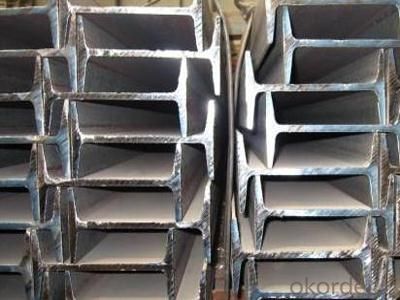
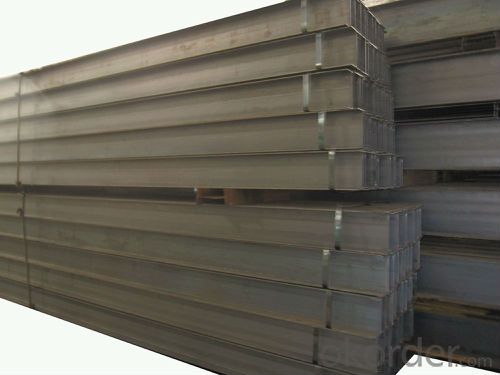

- Q:How do you transport and install steel H-beams?
- Transporting and installing steel H-beams requires careful planning and coordination to ensure safety and efficiency. Here are the steps involved in this process: 1. Assess the weight and dimensions: Determine the weight and dimensions of the steel H-beams to be transported. This information is crucial for selecting the appropriate transportation equipment and ensuring that the beams can be safely loaded and unloaded. 2. Select the right transportation equipment: Depending on the weight and size of the H-beams, you may need to use specialized transportation equipment such as flatbed trucks, trailers, or cranes. Ensure that the equipment is in good condition and capable of handling the load. 3. Secure the beams for transportation: Use appropriate securing methods to prevent the H-beams from shifting during transit. This may include using chains, straps, or binders to secure the beams to the trailer or truck bed. Consider using protective materials such as padding or covers to prevent damage during transportation. 4. Plan the route: Identify the best route for transportation, considering factors such as road conditions, height restrictions, weight limits, and any necessary permits. Plan the route to avoid obstacles such as low bridges or narrow passages that may hinder safe transportation. 5. Coordinate with the transportation company: Communicate with the transportation company to ensure they are aware of the specific requirements for transporting H-beams. Provide them with accurate information about the beams' weight, dimensions, and any special handling instructions. 6. Unload the beams: Upon arrival at the installation site, use appropriate equipment such as cranes or forklifts to safely unload the H-beams from the transportation vehicle. Ensure that the unloading area is clear of obstructions and that there is sufficient space for maneuvering the equipment. 7. Install the beams: Follow the manufacturer's instructions or engineering drawings to install the H-beams correctly. This may involve lifting the beams into position using cranes or other lifting equipment, aligning them accurately, and securing them in place using bolts or welding. 8. Ensure safety precautions: Throughout the transportation and installation process, prioritize safety. This includes providing personal protective equipment (PPE) for workers involved in handling the beams, conducting safety briefings, and adhering to established safety protocols. By following these steps and working with experienced professionals, you can ensure the safe and efficient transportation and installation of steel H-beams.
- Q:Can steel H-beams be used for supporting shipyard structures?
- Yes, steel H-beams can be used for supporting shipyard structures. They are commonly used in the construction of shipyards due to their high strength and load-bearing capacity. Steel H-beams provide structural stability and can withstand the heavy loads and dynamic forces exerted by ships during construction, repair, or maintenance.
- Q:What are the different connection details for steel H-beams?
- There are several different connection details for steel H-beams, which vary depending on the specific application and design requirements. Some common connection details include bolted connections, welded connections, and moment connections. Bolted connections involve using bolts and nuts to connect the beams together, providing flexibility for adjustment and disassembly. Welded connections involve fusing the beams together using welding techniques, providing a seamless and rigid connection. Moment connections are a type of welded connection that allows for the transfer of bending moments between beams, providing enhanced structural stability. Ultimately, the choice of connection detail depends on factors such as the load requirements, structural design, and construction methods being employed.
- Q:What are the common maintenance practices for steel H-beams?
- To maintain steel H-beams, it is necessary to conduct frequent visual inspections to detect any signs of damage or degradation, such as cracks, rust, or bending. It is important to regularly clean the beams to eliminate any debris or contaminants that may contribute to corrosion. Moreover, it is advisable to apply protective coatings like paint or galvanization to prevent rust and corrosion. These coatings should be inspected regularly and reapplied when needed. Regarding structural stability, it is crucial to ensure proper support for the H-beams and avoid subjecting them to excessive loads or stress. Regular assessments of the loads should be carried out to identify any potential issues and take appropriate measures to resolve them. In addition, monitoring the environment in which the H-beams are installed is crucial. Factors such as temperature, humidity, and exposure to chemicals or corrosive substances can affect their performance and durability. Taking necessary precautions and implementing measures to mitigate these risks is vital to maintain the longevity of the steel H-beams. Overall, regular inspections, cleaning, protective coatings, load assessments, and monitoring environmental conditions are essential maintenance practices for steel H-beams to ensure their structural integrity and prevent potential damage or degradation.
- Q:What are the dimensions of a steel H-beam?
- The dimensions of a steel H-beam can vary depending on the specific design and manufacturer. However, in general, H-beams typically have a height (also known as the web) ranging from 100 to 1200 millimeters and a flange width (the top and bottom horizontal sections) ranging from 55 to 400 millimeters. The thickness of the web and flanges can also vary.
- Q:Are steel H-beams suitable for high-rise buildings?
- Yes, steel H-beams are suitable for high-rise buildings. Steel H-beams have several advantages that make them an ideal choice for high-rise construction. Firstly, their high strength-to-weight ratio allows for the creation of lighter and more efficient structures. This is crucial in high-rise buildings where the weight of the structure needs to be minimized to reduce the load on the foundation and to improve overall stability. Secondly, steel H-beams have excellent load-bearing capacity, which is essential for supporting the weight of multiple floors and withstanding the forces exerted by wind, earthquakes, and other external factors. The inherent rigidity and strength of steel allow for the construction of tall buildings that can withstand these forces without compromising on stability or safety. Moreover, steel H-beams offer greater flexibility in terms of design and construction. Their versatility allows architects and engineers to create innovative and complex structures, enabling them to maximize floor space and create visually appealing designs. The ability to easily connect and join steel H-beams also facilitates faster construction, reducing overall project timelines. Furthermore, steel is a highly durable and long-lasting material. It is resistant to corrosion, fire, and pests, making it an ideal choice for high-rise buildings that are expected to have a long lifespan. Steel H-beams also require minimal maintenance, which is advantageous in terms of cost and convenience. In conclusion, steel H-beams are indeed suitable for high-rise buildings due to their high strength, load-bearing capacity, flexibility in design, and durability. These factors make steel H-beams a preferred choice for architects, engineers, and construction professionals when constructing tall buildings.
- Q:What are the different grades of steel used in H-beams?
- The different grades of steel commonly used in H-beams include A36, A572, and A992.
- Q:Can steel H-beams be used for signage structures?
- Yes, steel H-beams can be used for signage structures. Steel H-beams are known for their high strength and durability, making them suitable for supporting heavy loads, including signage. They are commonly used in construction projects for their structural integrity and ability to withstand various weather conditions. H-beams provide excellent support and stability, making them an ideal choice for signage structures that need to be sturdy and long-lasting. Additionally, steel H-beams can be easily fabricated and customized to meet specific design requirements, allowing for flexibility in creating unique and visually appealing signage structures.
- Q:H Elastic modulus of section steel
- The elastic modulus of steel is 2.1 * 10^7N/cm L.
- Q:Can steel H-beams be used for manufacturing facilities?
- Manufacturing facilities can indeed utilize steel H-beams. These beams are commonly employed in the construction industry for a range of purposes, including manufacturing facilities. With their exceptional strength, durability, and load-bearing capabilities, steel H-beams are well-suited for supporting the weight of heavy machinery, equipment, and structures within manufacturing plants. Moreover, H-beams offer a robust framework that can be easily fabricated and installed, making them an excellent option for constructing manufacturing facilities that necessitate expansive open spaces and wide spans. Furthermore, steel H-beams possess the capacity to endure high temperatures, rendering them appropriate for industries involving heat-intensive processes. In summary, steel H-beams are an adaptable and dependable choice for constructing manufacturing facilities, thanks to their structural integrity and capacity to handle substantial loads.
1. Manufacturer Overview |
|
|---|---|
| Location | |
| Year Established | |
| Annual Output Value | |
| Main Markets | |
| Company Certifications | |
2. Manufacturer Certificates |
|
|---|---|
| a) Certification Name | |
| Range | |
| Reference | |
| Validity Period | |
3. Manufacturer Capability |
|
|---|---|
| a)Trade Capacity | |
| Nearest Port | |
| Export Percentage | |
| No.of Employees in Trade Department | |
| Language Spoken: | |
| b)Factory Information | |
| Factory Size: | |
| No. of Production Lines | |
| Contract Manufacturing | |
| Product Price Range | |
Send your message to us
carbon steel H BEAM for construction JIS G 3192
- Loading Port:
- Tianjin
- Payment Terms:
- TT or LC
- Min Order Qty:
- 25 m.t.
- Supply Capability:
- 100000 m.t./month
OKorder Service Pledge
OKorder Financial Service
Similar products
New products
Hot products
Related keywords
